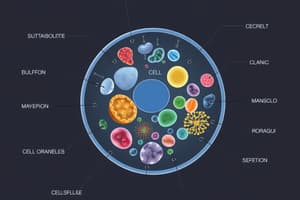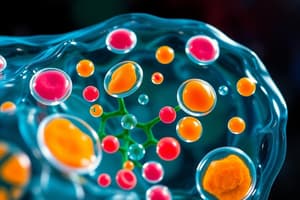Podcast
Questions and Answers
Which of the following statements is NOT part of Cell Theory?
Which of the following statements is NOT part of Cell Theory?
- All cells are the smallest unit of life.
- Some organisms are multicellular.
- All cells come from preexisting cells.
- All organisms are unicellular. (correct)
Eukaryotic cells do not contain membrane-bound organelles.
Eukaryotic cells do not contain membrane-bound organelles.
False (B)
What is the function of ribosomes in a cell?
What is the function of ribosomes in a cell?
They synthesize proteins.
The ____ is the control center of the cell and contains genetic information.
The ____ is the control center of the cell and contains genetic information.
What is the primary function of the cell membrane?
What is the primary function of the cell membrane?
Match the following cell organelles with their functions:
Match the following cell organelles with their functions:
Prokaryotic cells have DNA contained within a nucleus.
Prokaryotic cells have DNA contained within a nucleus.
What is the difference in DNA location between prokaryotic and eukaryotic cells?
What is the difference in DNA location between prokaryotic and eukaryotic cells?
Which type of molecules can pass directly through the membrane via simple diffusion?
Which type of molecules can pass directly through the membrane via simple diffusion?
Osmosis is the movement of water molecules from low solute concentration to high solute concentration.
Osmosis is the movement of water molecules from low solute concentration to high solute concentration.
What happens to an animal cell placed in a hypotonic solution?
What happens to an animal cell placed in a hypotonic solution?
The process of taking material into the cell is called __________.
The process of taking material into the cell is called __________.
Match the transport process with its correct description:
Match the transport process with its correct description:
What does the term 'hypertonic' refer to?
What does the term 'hypertonic' refer to?
Plasmolysis occurs when plant cells are placed in a hypotonic solution.
Plasmolysis occurs when plant cells are placed in a hypotonic solution.
Define the role of aquaporins in passive transport.
Define the role of aquaporins in passive transport.
A __________ is a type of active transport that uses energy to move substances against their concentration gradient.
A __________ is a type of active transport that uses energy to move substances against their concentration gradient.
What is the best solution for animal cells to maintain their shape?
What is the best solution for animal cells to maintain their shape?
What is the primary function of the Golgi apparatus?
What is the primary function of the Golgi apparatus?
Lysosomes are involved in intracellular digestion.
Lysosomes are involved in intracellular digestion.
What is the main function of chloroplasts?
What is the main function of chloroplasts?
The __________ stores energy in the form of ATP.
The __________ stores energy in the form of ATP.
Match the organelles to their functions:
Match the organelles to their functions:
Which of the following organelles is found only in plant cells?
Which of the following organelles is found only in plant cells?
The cell membrane is completely impermeable to all substances.
The cell membrane is completely impermeable to all substances.
What is passive transport?
What is passive transport?
The __________ in plant cells helps to maintain their firmness by storing water.
The __________ in plant cells helps to maintain their firmness by storing water.
What part of the cell membrane is hydrophobic?
What part of the cell membrane is hydrophobic?
Ribosomes are involved in the synthesis of proteins.
Ribosomes are involved in the synthesis of proteins.
What is the role of cholesterol in the cell membrane?
What is the role of cholesterol in the cell membrane?
The __________ operates under a fluid mosaic model, allowing parts to move around.
The __________ operates under a fluid mosaic model, allowing parts to move around.
Match the types of molecules to their transport methods:
Match the types of molecules to their transport methods:
Active transport moves molecules from low concentration to high concentration.
Active transport moves molecules from low concentration to high concentration.
Flashcards
Cell
Cell
The basic, fundamental unit of life. All living organisms are made up of at least one cell.
Cell Theory
Cell Theory
A theory stating that all living organisms are composed of cells, cells arise from pre-existing cells, and that the cell is the fundamental unit of structure and function in living organisms.
Prokaryotic Cell
Prokaryotic Cell
A type of cell that lacks a nucleus and other membrane-bound organelles. DNA is free-floating within the cytoplasm.
Eukaryotic Cell
Eukaryotic Cell
Signup and view all the flashcards
Cell Wall
Cell Wall
Signup and view all the flashcards
Cell Membrane
Cell Membrane
Signup and view all the flashcards
Cytoplasm
Cytoplasm
Signup and view all the flashcards
Nucleus
Nucleus
Signup and view all the flashcards
Nucleolus
Nucleolus
Signup and view all the flashcards
Ribosomes
Ribosomes
Signup and view all the flashcards
Smooth ER
Smooth ER
Signup and view all the flashcards
Rough ER
Rough ER
Signup and view all the flashcards
Simple Diffusion
Simple Diffusion
Signup and view all the flashcards
Facilitated Diffusion
Facilitated Diffusion
Signup and view all the flashcards
Osmosis
Osmosis
Signup and view all the flashcards
Aquaporin
Aquaporin
Signup and view all the flashcards
Solute
Solute
Signup and view all the flashcards
Solvent
Solvent
Signup and view all the flashcards
Solution
Solution
Signup and view all the flashcards
Hypertonic Solution
Hypertonic Solution
Signup and view all the flashcards
Hypotonic Solution
Hypotonic Solution
Signup and view all the flashcards
Isotonic Solution
Isotonic Solution
Signup and view all the flashcards
What is the Golgi apparatus?
What is the Golgi apparatus?
Signup and view all the flashcards
What are lysosomes?
What are lysosomes?
Signup and view all the flashcards
What are vacuoles?
What are vacuoles?
Signup and view all the flashcards
What are mitochondria?
What are mitochondria?
Signup and view all the flashcards
What is the endoplasmic reticulum (ER)?
What is the endoplasmic reticulum (ER)?
Signup and view all the flashcards
What is passive transport?
What is passive transport?
Signup and view all the flashcards
What is facilitated diffusion?
What is facilitated diffusion?
Signup and view all the flashcards
What is simple diffusion?
What is simple diffusion?
Signup and view all the flashcards
Explain the process of protein synthesis and transport.
Explain the process of protein synthesis and transport.
Signup and view all the flashcards
What is active transport?
What is active transport?
Signup and view all the flashcards
What is the endomembrane system?
What is the endomembrane system?
Signup and view all the flashcards
What is selective permeability?
What is selective permeability?
Signup and view all the flashcards
Why is the cell membrane called a 'fluid mosaic model'?
Why is the cell membrane called a 'fluid mosaic model'?
Signup and view all the flashcards
What is photosynthesis?
What is photosynthesis?
Signup and view all the flashcards
What are chloroplasts?
What are chloroplasts?
Signup and view all the flashcards
Study Notes
Cell Theory
- Cells are the fundamental units of life.
- Some organisms are single-celled (unicellular), others are multicellular.
- All cells arise from pre-existing cells.
Prokaryotic vs. Eukaryotic Cells
- Prokaryotes:
- Examples: Bacteria
- Lack membrane-bound organelles.
- DNA is not enclosed in a nucleus; it floats freely.
- Smaller and simpler than eukaryotes, but capable of growth, reproduction, response to the environment, and movement.
- Eukaryotes:
- Diverse range of organisms (animals, plants, fungi).
- Contain membrane-bound organelles.
- DNA is enclosed within a nucleus.
- Larger and more complex than prokaryotic cells.
Cell Structures and Functions
- Cell Wall:
- Function: Protection, shape maintenance, prevents excessive water uptake.
- Structure: Composed of cellulose (and other components).
- Found in plant and certain bacterial cells.
- Cell Membrane:
- Function: Regulates what enters/leaves the cell, provides protection, flexible support.
- Structure: Phospholipid bilayer with embedded proteins.
- Found in all cells.
- Cytoplasm/Cytosol:
- Cytoplasm: Everything within the cell membrane except the nucleus.
- Cytosol: The jelly-like fluid surrounding organelles.
- Found in all cells.
- Nucleus:
- Function: Control center; contains DNA (genetic information).
- Structure: Surrounded by double membrane (nuclear envelope) with pores for material transport.
- Contains nucleolus (ribosome production site).
- Found in eukaryotic cells.
- Nucleolus:
- Function: Ribosome production.
- Location: Inside the nucleus.
- Found in eukaryotic cells.
- Ribosomes:
- Function: Protein synthesis.
- Structure: RNA and protein; two subunits.
- Found in both prokaryotic and eukaryotic cells.
- Smooth ER:
- Function: Lipid synthesis, detoxification.
- Structure: Network of folded membranes.
- Found in eukaryotic cells.
- Rough ER:
- Function: Protein modification & transport (proteins enter for folding and processing).
- Structure: Network of folded membranes with ribosomes attached.
- Found in eukaryotic cells.
- Golgi Apparatus:
- Function: Modifies, sorts, and packages proteins for secretion or intracellular use.
- Structure: Stacked membrane sacs.
- Found in eukaryotic cells.
- Lysosomes:
- Function: Intracellular digestion (breakdown of molecules, damaged organelles, or cellular waste).
- Structure: Membrane-bound sacs containing hydrolytic enzymes (pH 5).
- Found in eukaryotic cells.
- Vacuoles & Vesicles:
- Function: Storage of substances and transport within the cell.
- Structure: Membrane sacs.
- Vacuoles: Larger, for storage.
- Vesicles: Smaller, for transport.
- Found in eukaryotic cells.
- Chloroplasts:
- Function: Photosynthesis (conversion of light energy to chemical energy).
- Structure: Double-membrane-bound organelle, contains chlorophyll, stroma, and thylakoids.
- Found in plant cells.
- Mitochondria:
- Function: Cellular respiration (energy production from food to ATP).
- Structure: Double-membrane-bound organelle, cristae for ATP synthesis.
- Found in plant and animal cells.
- Central Vacuole (Plant Cells):
- Function: Maintains cell shape and turgor pressure, stores water.
- Structure: Large membrane-bound sac (tonoplast).
- Found in plant cells.
Protein Synthesis and Transport
- Ribosomes synthesize proteins.
- Proteins enter the rough ER for modification.
- Proteins travel to the Golgi apparatus for sorting and packaging.
- Proteins are then shipped to their destinations within or outside the cell.
Endomembrane System
- Interchangeable membranes (e.g., ER, Golgi, lysosomes, vesicles).
Cell Membrane Structure and Function
- Structure: Phospholipid bilayer with embedded proteins and cholesterol.
- Phospholipids: Form the bilayer, regulate permeability.
- Proteins: Facilitate transport and other functions.
- Cholesterol: Maintains fluidity and stability.
- Fluid Mosaic Model: Parts of the membrane can move.
- Selectively Permeable: Membrane controls what passes through.
Cellular Transport
- Passive Transport:
- Movement from high to low concentration, no energy required.
- Examples: Simple diffusion, facilitated diffusion, osmosis.
- Active Transport:
- Movement from low to high concentration, requires ATP.
- Simple Diffusion:
- Small, nonpolar molecules pass directly through the membrane.
- Facilitated Diffusion:
- Large, polar, or charged molecules use transport proteins to pass through.
- Osmosis:
- Water movement across a selectively permeable membrane, often through aquaporin channels.
- Tonicity:
- Hypertonic: High solute concentration outside the cell.
- Hypotonic: Low solute concentration outside the cell.
- Isotonic: Equal solute concentrations.
- Animal Cell responses to solutions
- Hypertonic: Shrinks (crenate), may shrivel.
- Hypotonic: Swells, may lyse (burst).
- Isotonic: Retains normal shape.
- Plant Cell responses to solutions:
- Hypertonic: Plasmolysis (shrinks away from cell wall).
- Hypotonic: Turgid (normal state).
- Isotonic: Flaccid (less firm).
- Active Transport:
- Moves substances against a concentration gradient, requiring energy.
- Uses specialized protein pumps across the membrane.
- Endocytosis: Taking materials into the cell.
- Exocytosis: Removing materials from the cell.
- Phagocytosis: Cellular eating (engulfing large particles).
- Pinocytosis: Cellular drinking (engulfing dissolved materials).
Scientific Method and Lab Review
- Review scientific method, experimental design, and graphing techniques.
- Review completed labs and class materials.
Studying That Suits You
Use AI to generate personalized quizzes and flashcards to suit your learning preferences.




